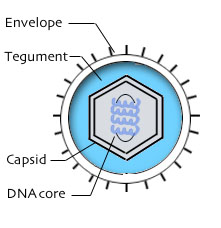Bovine Herpesvirus 1
A Viral Biorealm page on the family Bovine Herpesvirus 1
Baltimore Classification
Group 1: Double-Stranded DNA Viruses
Higher Order Categories
Order: Herpesvirales
Family: Herpesviridae
Subfamily: Alphaherpesviridae
Genus: Varicellovirus
Description and Significance
Genome Structure
Virion Structure of Bovine herpesvires 1

Image source: Los Alamos National Laboratory Bioscience Division.
BoHV-1 has a typical herpesvirus virion structure: the virus's double stranded DNA genome is contained within an icosahedral protein capsid. The capsid is wrapped in a protein complex called the tegument, which is made up of about 20 viral proteins. The tegument connects the capsid with the outer cell-derived envelope, which contains the viral membrane proteins and glycoproteins that are essential for the successful penetration of the cell membrane, including glycoproteins gD, gB, gH, and gL.
Reproductive Cycle of Bovine herpesvirus 1 in a Host Cell
The BoHV-1 virion penetrates the cell membrane via a three step process. First, glycoproteins gB and gC on the virion envelope interact with certain cellular structures, creating a low affinity attachment between the virus and the host cell. Second, glycoprotein gD binds to cell membrane protein nectin-1, an immunoglobulin protein. This initiates the third phase, when the virion envelope fuses with the cell membrane, allowing the capsid and tegument to enter the cytoplasm.
Upon entering the host cell, the virion begins to move towards the nucleus. As it is transported, the tegument proteins surrounding the capsid are shed into the cytoplasm. Although many of these tegument proteins are poorly understood, some are known to have important functions, such as disabling host defenses or subverting the host's resources. For example, the virion host shutoff (vhs) tegument protein is responsible for halting the host's regular protein synthesis, and tegument protein VP16 is required to induce expression of early BoHV-1 genes.
Once it reaches the nucleus, the viral genome is thought to circularize, and a combination of viral and cellular proteins induces the expression of the "immediate early" (IE) genes. The IE gene products induce the expression of "early" genes, at which point viral DNA replication begins. "Early late" gene expression begins during viral genome replication, and then finally the "true late" genes are expressed, which code for the capsid-forming structural proteins.
Meanwhile, replication of the now-circular viral genome proceeds via a "rolling circle" mechanism, which produces multiple genomes connected to each other in sequence from head to tail (concatemeric DNA), which are then cleaved into individual copies.
Viral Ecology and Pathology
References
[1] Labiuk, Shaunivan L.; Babiuk, Lorne A.; van Drunen Littel-van den Hurk, Sylvia. "Major tegument protein VP8 of bovine herpesvirus 1 is phosphorylated by viral US3 and cellular CK2 protein kinases." J. Gen. Vir. 90 (2009): 2829-39.
[2] Muylkens, Benoit; Thiry, Julien; Kirten, Philippe; Schynts, Frederic; Thiry, Etienne. "Bovine herpesvirus 1 infection and infectious bovine rhinotracheitis." Vet. Res. 38 (2007): 181-209.
Page authored for BIOL 375 Virology, September 2010
